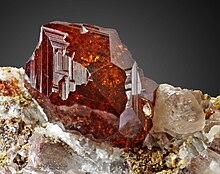| Garnet | |
|---|---|
 | |
| General | |
| Category | Nesosilicate |
| Formula (repeating unit) | The general formula X3Y2(SiO4)3 |
| IMA symbol | Grt[1] |
| Crystal system | Isometric |
| Crystal class | |
| Space group | Ia3d |
| Identification | |
| Color | virtually all colors, blue is rare |
| Crystal habit | Rhombic dodecahedron or cubic |
| Cleavage | Indistinct |
| Fracture | conchoidal to uneven |
| Mohs scale hardness | 6.5–7.5 |
| Luster | vitreous to resinous |
| Streak | White |
| Diaphaneity | Can form with any diaphaneity, translucent is common |
| Specific gravity | 3.1–4.3 |
| Polish luster | vitreous to subadamantine[2] |
| Optical properties | Single refractive, often anomalous double refractive[2] |
| Refractive index | 1.72–1.94 |
| Birefringence | None |
| Pleochroism | None |
| Ultraviolet fluorescence | variable |
| Other characteristics | variable magnetic attraction |
| Major varieties | |
| Pyrope | Mg3Al2Si3O12 |
| Almandine | Fe3Al2Si3O12 |
| Spessartine | Mn3Al2Si3O12 |
| Andradite | Ca3Fe2Si3O12 |
| Grossular | Ca3Al2Si3O12 |
| Uvarovite | Ca3Cr2Si3O12 |
Garnets ( /ˈɡɑːrnɪt/) are a group of silicate minerals that have been used since the Bronze Age as gemstones and abrasives.
All species of garnets possess similar physical properties and crystal forms, but differ in chemical composition. The different species are pyrope, almandine, spessartine, grossular (varieties of which are hessonite or cinnamon-stone and tsavorite), uvarovite and andradite. The garnets make up two solid solution series: pyrope-almandine-spessartine (pyralspite), with the composition range [Mg,Fe,Mn]3Al2(SiO4)3; and uvarovite-grossular-andradite (ugrandite), with the composition range Ca3[Cr,Al,Fe]2(SiO4)3.
- ^ Warr, L. N. (2021). "IMA–CNMNC approved mineral symbols". Mineralogical Magazine. 85 (3): 291–320. Bibcode:2021MinM...85..291W. doi:10.1180/mgm.2021.43. S2CID 235729616.
- ^ a b Cite error: The named reference
GRGwas invoked but never defined (see the help page).
